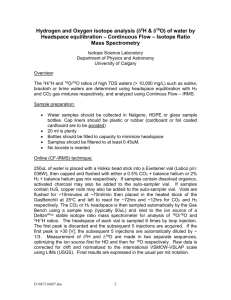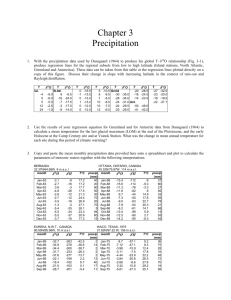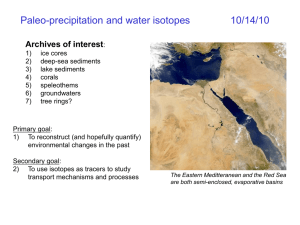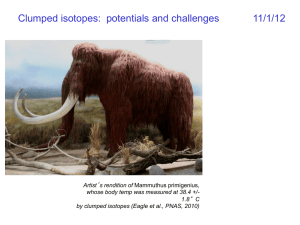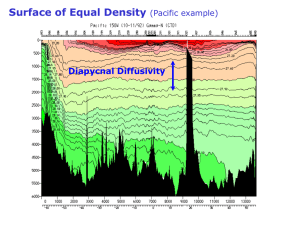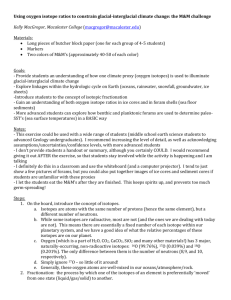Oerter_EPS209_Talk
advertisement
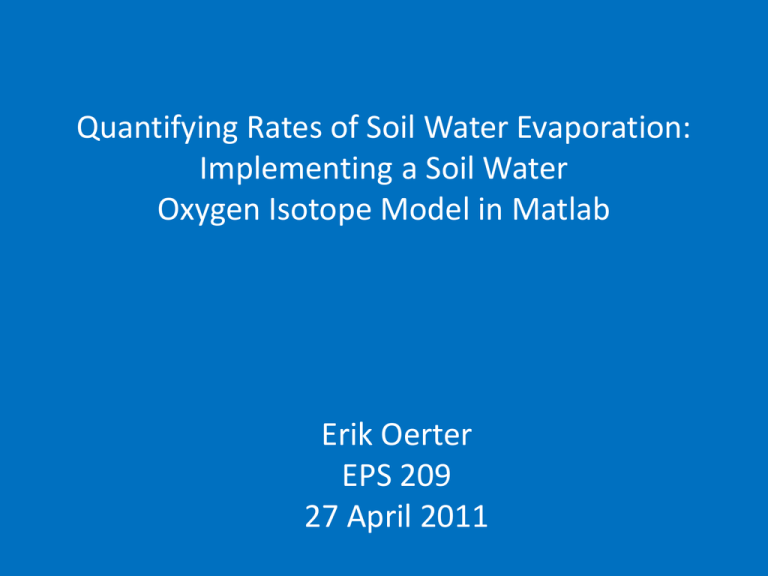
Quantifying Rates of Soil Water Evaporation: Implementing a Soil Water Oxygen Isotope Model in Matlab Erik Oerter EPS 209 27 April 2011 Project Motivation: Soil Water Oxygen Isotopes Soil Water originates as meteoric water, preserving the isotopic signature of precipitation Hydrogen and Oxygen isotopes undergo Rayleigh fractionation as water evaporates Enrichment in 18O relative to precipitation The 18O/16O can be sampled: Directly as soil water (contemporary water) Indirectly as CaCO3 (ancient water) Use 18O/16O to estimate evaporation rate Climate Proxy Evaporation Rate via Soil Water Oxygen Isotopes Evap. Rate 18O/16O of water at “z” in soil profile 𝑹𝒘 𝒛 = 𝟏 Depth in soil profile 𝑬 𝒛−𝒛𝒆𝒇 − 𝑫 −𝒆 𝟏− Diff coef. of water in soil 𝑬 𝑳−𝒛𝒆𝒇 − 𝑫 𝒆 18O/16O of water at depth 𝑹𝒘,𝒓𝒆𝒔 − 𝑹𝒘,𝒆𝒇 + 𝑹𝒘,𝒆𝒇 18O/16O Depth of evap. front of water at evap. front L = Total depth of soil profile (Barnes and Allison, 1988, J. of Hydrology) Project Idea: Fit modeled Oxygen isotope profile to observed data and find the evaporation rate Model 18O profile Observed 18O profile Data from Wang et al., 1996 Project Approach: m-file Sequence of Events 1) Load in observed data as text file 2) Initialize variables - Make an initial guess for evaporation rate - Populate a vector with evap guesses (~100) Specify the step between evap guesses - Initialize a matrix for calculated 18O profiles (# depth increments x # evap guesses) 3) Loop over all evap guesses, calculating 18O profiles - Now have 100 18O profiles… Project Approach: m-file Sequence of Events 4) Compare the model 18O profiles to the observed data using a Chi square measure: 2 𝑥 = (𝑜𝑏𝑠𝑒𝑟𝑣𝑒𝑑−𝑚𝑜𝑑𝑒𝑙)2 𝑢𝑛𝑐𝑒𝑟𝑡𝑎𝑖𝑛𝑡𝑦 2 5) Plot 𝑥 2 vs Evap guesses - Find the minimum 6) Display the best fit Evap guess Some Results Diffusion Coefficient of Water in Soil = 1.5*10-10 m2/sec Starting Evap Rate Guess = 5x10-11 m/sec (0.15 cm/year) E guess step = 1*10-12 m/sec Best fit Evap rate = 1.02*10-10 m/sec (0.32 cm/year) 18O/16O -9 -8 -7 -6 -5 -4 -3 0 0.1 0.2 0.3 Depth 0.4 0.5 0.6 0.7 0.8 Observed 0.9 Model 1 -2 Future Work This interpretation of the Barnes and Allison Model: - Single wet soil zone with the evaporating front at the surface Barnes and Allison envisioned a dry zone of soil overlying the wet zone and evaporating front at some depth Implement the two zone scheme - Allow for a migrating (+/- depth) evaporation front Allow for resetting of the 18O input value (Allow it to rain on the soil)

